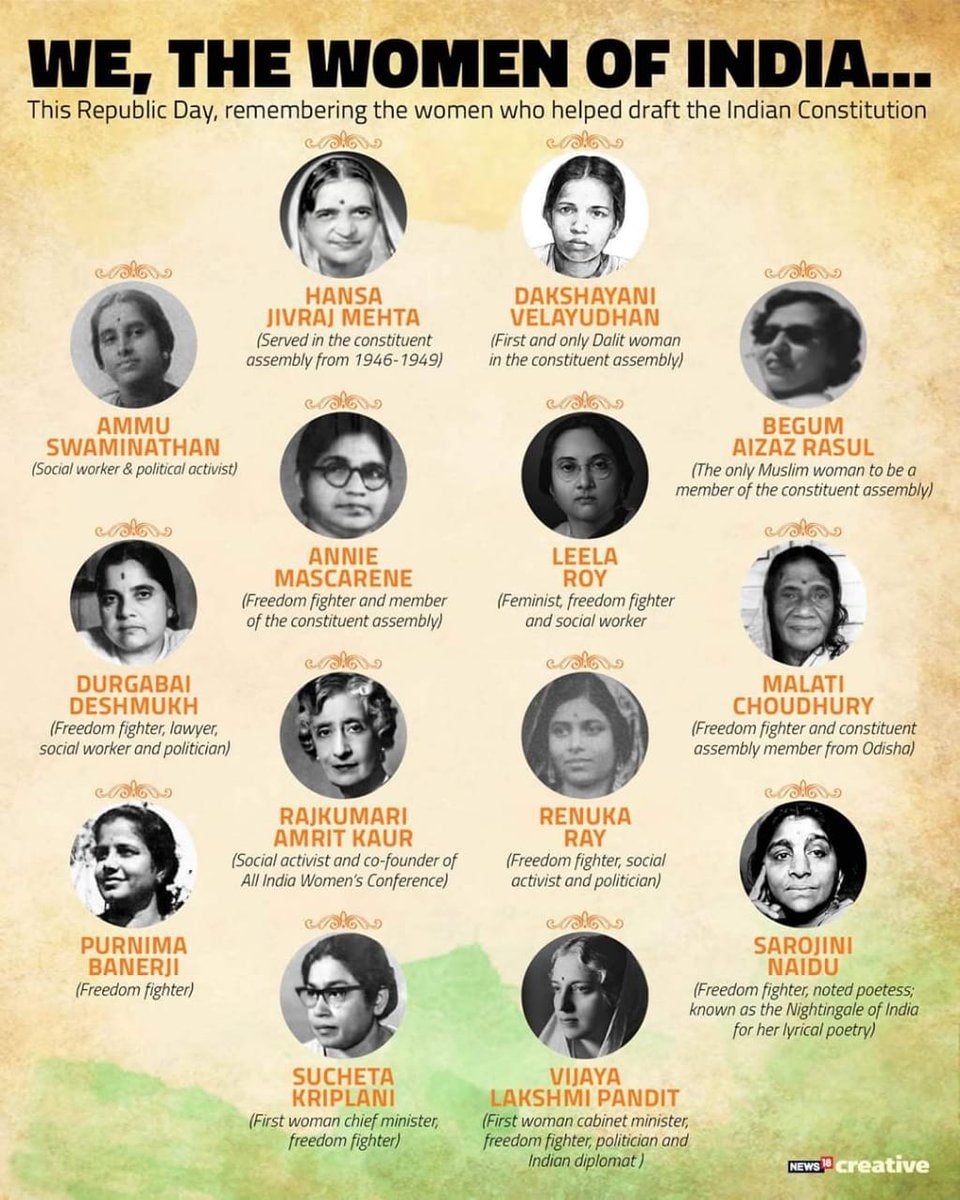As we pledge on the Constitution it is important to know more about its structure and democratic values
Introduction to Women Members of the Constituent Assembly – Part 2
(continued from the blog published on 31st January, 2024)
1. Renuka Ray – Ray dedicated her efforts to combat women trafficking and enhance the working conditions of female laborers. Taking a firm stance against the reservation of seats for women, she had emphasised that such measures undermine women’s capabilities and potentials, asserting, “We feel that women will get more chances in the future to come forward and work in the free India, if the consideration is of ability alone.” She ardently supported the Clause abolishing reservations for women, deeming it essential for fostering growth and respecting women’s intelligence and capacity. In addition to her advocacy against gender-based discrimination, she actively contributed to various women’s rights issues, minority rights, and the establishment of a bicameral legislature. Notably, she championed the Uniform Personal Law Code and advocated for equality in education, expressing concerns about religious instruction in publicly funded institutions. Her relentless campaigning extended to securing women’s rights and inheritance rights in parental property, reflecting her unwavering commitment to social justice and equality.
2. Sarojini Naidu – Sarojini Naidu emphasised the significance of a national flag, affirming, “we vindicate, and we salute this Flag under which so many hundreds and thousands of us have fought and suffered.” Additionally, she highlighted the evolving global civilisation, advocating for the elimination of sex consciousness and separation in national service. Notably, she made history as the first Indian woman to serve as the president of the Indian National Congress and later as the first woman appointed as an Indian state governor.
3. Sucheta Kripalani – In the constituent assembly, Sucheta Kripalani sang first verse of Vande Mataram, the national song (saare Jahan se achcha) and the national anthem (Jana gana mana). Additionally, Kriplani assumed the role of Secretary within the Relief and Rehabilitation Committee established by the Congress Party, where she played a crucial role in the rehabilitation efforts for Bengali refugees affected by the partition.
4. Leela Roy – Roy, a dedicated freedom fighter and social worker, devoted her life to the advancement of women’s education in India. Remarkably, she held the distinction of being the sole elected female representative from Bengal to the Assembly. Demonstrating her commitment to principles, Roy resigned from her position as a bold protest against the partition of India. Notably, she shared a close association with Netaji Subhash Chandra Bose. In 1946, during the distressing Kolkata riots, Roy played a crucial role in assisting the victims and subsequently established the National Service Institute for Rescue and Relief Work at Noakhali. Her unwavering dedication extended to advocating for the rights of refugees, showcasing her tireless efforts in contributing to social causes.
5. Malati Choudhary: Initially elected to the Constituent Assembly from Orissa on a Congress ticket, Malati opted to resign from her position in the same year. Her decision stemmed from a desire to collaborate directly with Mahatma Gandhi and a personal sentiment of feeling ‘unfit’ for the role. Preferring to engage in grassroots activism, she dedicated herself to uplifting marginalised communities in Odisha, particularly farmers, Dalits, tribals, and children. To further her mission, she established various organisations, including the Bajiraut Chhatravas, focusing on the betterment of vulnerable populations in the region.
6. Rajkumari Amrit Kaur – Kaur made a significant impact by advocating for extensive political engagement of women, contributing significantly to India’s attainment of constitutional gender equality as enshrined in Articles 14, 15, and 16. Additionally, she played a pivotal role in the incorporation of the Uniform Civil Code into the Directive Principles of State Policy. Serving as India’s first Health Minister for a decade, she also made history as the first female and first Asian President of the World Health Assembly. Notably, within the sub-committee, she voiced opposition to including freedom of religious practice in the constitution, citing concerns about potential protection for discriminatory practices like purdah, sati, and the devadasi system. Her advocacy led to the insertion of a clause ensuring that religious freedoms would not impede the State’s ability to enact laws for social reform, ultimately reflected in the Constitution.
7. Vijaya Lakshmi Pandit – Vijaya Lakshmi Pandit made history in 1953 by becoming the first woman to serve as President of the UN General Assembly. Upon her return to India, she was appointed as the governor of Maharashtra. Earlier in her career, she was elected to the Constituent Assembly and in 1937, she achieved another milestone by becoming the Minister of Local Self-Government and Public Health, marking her as the first Indian woman to hold a cabinet minister position.
8. Kamala Chaudhary – Kamala, a Constituent Assembly member, continued her service in the Provincial Government of India following the adoption of the constitution until 1952. She further contributed to Indian politics by assuming the role of Senior Vice-Chair during the 54th Indian National Congress Session.
The women members of the Constituent Assembly of India played a pivotal role in shaping the country’s foundational document, The Constitution. Their participation demonstrated a commitment to equality and inclusion, paving the way for gender-sensitive provisions within the Constitution. Through their contributions, they left a lasting legacy, highlighting the importance of women’s representation in the nation-building process.
Sources:
1. https://timesofindia.indiatimes.com/readersblog/third-view/the-15-forgotten-women-leaders-of-the-constituent-assembly-of-india-46951/
2. https://www.constitutionofindia.net/members/renuka-ray/
3. https://cdgi.edu.in/pdf/Women_who_contributed_to_Indian_Constitution.pdf
4. https://cms.rajyasabha.nic.in/UploadedFiles/ElectronicPublications/Selected%20Women%20Speech_Final.pdf
5. https://www.constitutionofindia.net/the-constitution-framers/?_framers_search=kaur
6. https://www.indiatoday.in/education-today/gk-current-affairs/story/women-s-day-the-only-15-women-who-contributed-to-making-the-indian-constitution-1653496-2020-03-07
7. https://www.civilsdaily.com/news/womens-role-in-constitution-building/
8. https://www.civilsdaily.com/news/women-in-the-making-of-constitution-of-india/
9. Image Courtesy – News18 Creative + https://www.civilsdaily.com/news/women-in-the-making-of-constitution-of-india/




